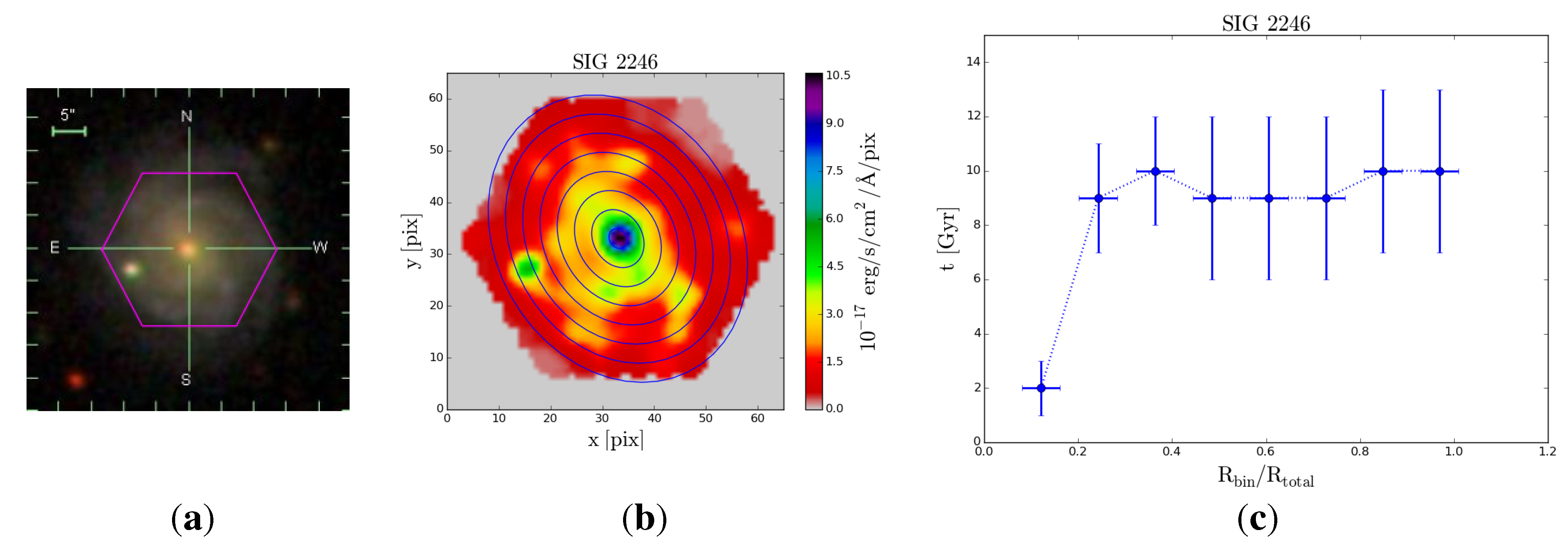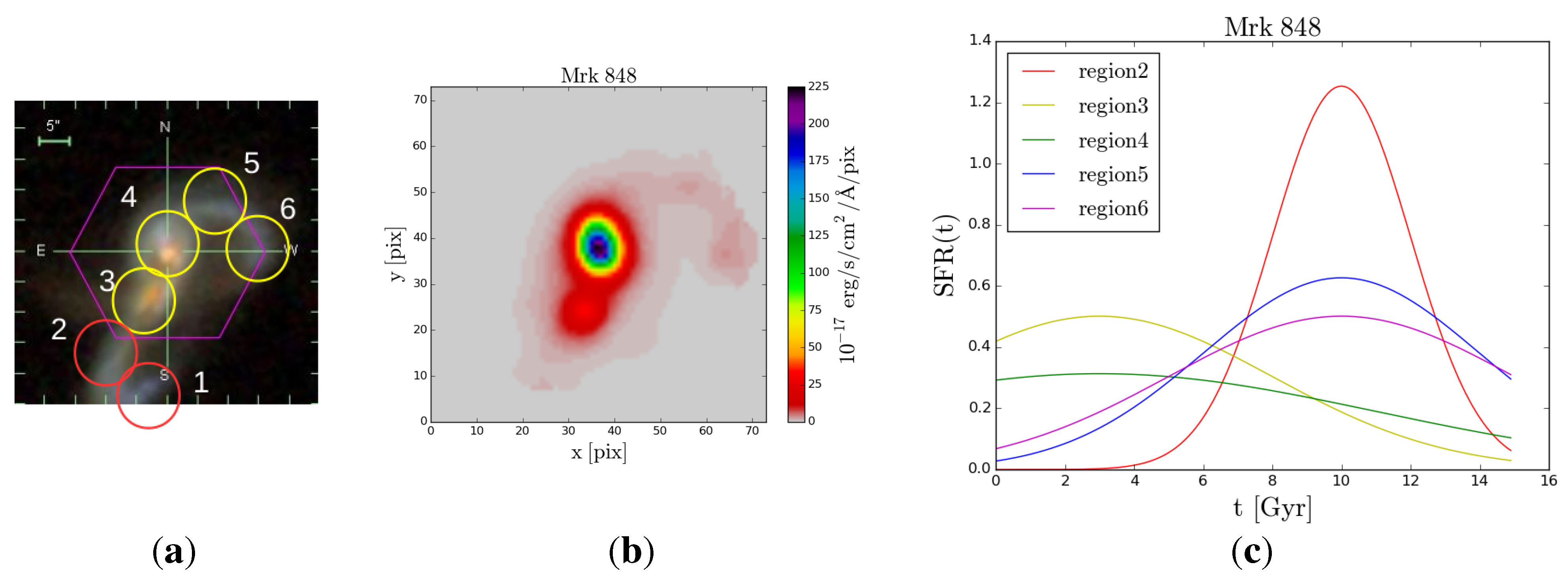Isolated Galaxies versus Interacting Pairs with MaNGA
Abstract
:1. Introduction
2. Experimental Section
2.1. Data


2.2. Methodology
3. Results and Discussion
3.1. SIG 2246
3.2. Mrk 848
4. Conclusions
- (1)
- We presented preliminary results of the study of the evolution of SIG 2246, an almost face-on spiral isolated galaxy, using IFS from MaNGA, which is up to now the largest IFU survey for galaxies in the local Universe. We find a radial gradient in the SFH of SIG 2246. Our results are in agreement with a scenario where spiral galaxies are built from inside-out.
- (2)
- We also apply the same methodology to study the SFH in the galaxy merger Mrk 848. We find evidence that interactions keep star formation in the central part of the galaxies.
Acknowledgments
Author Contributions
Conflicts of Interest
References
- Kepner, J.V. Inside-out galaxy formation. Astrophys. J. 1999, 520, 59. [Google Scholar] [CrossRef]
- Pilkington, K.; Few, C.G.; Gibson, B.K.; Calura, F.; Michel-Dansac, L.; Thacker, R.J.; Mollá, M.; Matteucci, F.; Rahimi, A.; Kawata, D.; et al. Metallicity gradients in disks Do galaxies form inside-out? Astron. Astrophys. 2012, 540, A56. [Google Scholar] [CrossRef]
- Sánchez, S.F.; Rosales-Ortega, F.F.; Iglesias-Páramo, J.; Mollá, M.; Barrera-Ballesteros, J.; Marino, R.A.; Pérez, E.; Sánchez-Blazquez, P.; González Delgado, R.; Cid Fernandes, R.; et al. A characteristic oxygen abundance gradient in galaxy disks unveiled with CALIFA. Astron. Astrophys. 2014, 563, A49. [Google Scholar] [CrossRef]
- Sánchez, S.F.; Kennicutt, R.C.; Gil de Paz, A.; van de Ven, G.; Vĺłlchez, J.M.; Wisotzki, L.; Walcher, C.J.; Mast, D.; Aguerri, J.A.L.; Albiol-Pérez, S.; et al. CALIFA, the Calar Alto Legacy Integral Field Area survey-I. Survey presentation. Astron. Astrophys. 2012, 538, A8. [Google Scholar] [CrossRef]
- Pérez, E.; Cid Fernandes, R.; González Delgado, R.M.; García-Benito, R.; Sánchez, S.F.; Husemann, B.; Mast, D.; Rodón, J.R.; Kupko, D.; Backsmann, N.; et al. The Evolution of Galaxies Resolved in Space and Time: A View of Inside-out Growth from the CALIFA Survey. Astrophys. J. Lett. 2013, 764, L1. [Google Scholar] [CrossRef]
- Sánchez-Blázquez, P.; Rosales-Ortega, F.F.; Méndez-Abreu, J.; Pérez, I.; Sánchez, S.F.; Zibetti, S.; Aguerri, J.A.L.; Bland-Hawthorn, J.; Catalán-Torrecilla, C.; Cid Fernandes, R.; et al. Stellar population gradients in galaxy discs from the CALIFA survey: the influence of bars. Astron. Astrophys. 2014, 570, A6. [Google Scholar] [CrossRef]
- Pan, Z.; Li, J.; Lin, W.; Wang, J.; Fan, L.; Kong, X. From Outside-in to Inside-out: Galaxy Assembly Mode Depends on Stellar Mass. Astrophys. J. Lett. 2015, 804, L42. [Google Scholar] [CrossRef]
- Bundy, K.; Bershady, M.A.; Law, D.R.; Yan, R.; Drory, N.; MacDonald, N.; Wake, D.A.; Cherinka, B.; Sánchez-Gallego, J.R.; Weijmans, A.-M.; et al. Overview of the SDSS-IV MaNGA Survey: Mapping nearby Galaxies at Apache Point Observatory. Astrophys. J. 2015, 798, 7. [Google Scholar] [CrossRef]
- Li, C.; Wang, E.; Lin, L.; Bershady, M.A.; Bundy, K.; Tremonti, C.A.; Xiao, T.; Yan, R.; Bizyaev, D.; Blanton, M.; et al. P-MaNGA: Gradients in Recent Star Formation Histories as Diagnostics for Galaxy Growth and Death. Astrophys. J. 2015, 804, 125. [Google Scholar] [CrossRef]
- Argudo-Fernández, M.; Verley, S.; Bergond, G.; Duarte Puertas, S.; Ramos Carmona, E.; Sabater, J.; Fernandez Lorenzo, M.; Espada, D.; Sulentic, J.; Ruiz, J.E.; Leon, S. Catalogues of isolated galaxies, isolated pairs, and isolated triplets in the local Universe. Astron. Astrophys. 2015, 578, A110. [Google Scholar] [CrossRef]
- Chang, R.X.; Hou, J.L.; Shu, C.G.; Fu, C.Q. Two-component model for the chemical evolution of the Galactic disk. Astron. Astrophys. 1999, 350, 38. [Google Scholar]
- Bruzual, G.; Charlot, S. Stellar population synthesis at the resolution of 2003. Mon. Not. R. Astron. Soc. 2003, 344, 1000–1028. [Google Scholar] [CrossRef]
- Salpeter, E.E. The luminosity function and stellar evolution. Astrophys. J. 1955, 121, 161. [Google Scholar] [CrossRef]
- Cid Fernandes, R.; González Delgado, R.M.; García Benito, R.; Pérez, E.; de Amorim, A.L.; Sánchez, S.F.; Husemann, B.; Falcón Barroso, J.; López-Fernández, R.; Sánchez-Blázquez, P.; et al. Resolving galaxies in time and space II. Uncertainties in the spectral synthesis of datacubes. Astron. Astrophys. 2014, 561, A130. [Google Scholar] [CrossRef]
- Sánchez, S.F.; Pérez, E.; Sánchez-Blázquez, P.; González, J.J.; Rosález-Ortega, F.F.; Cano-Díaz, M.; López-Cobá, C.; Marino, R.A.; de Paz, A.G.; Mollá, M.; et al. Pipe3D, A Pipeline to Analyze Integral Field Spectroscopy Data: I. New Fitting Phylosophy of FIT3D; Cornell Unversity: Ithaca, NY, USA, 2015. [Google Scholar]
© 2015 by the authors; licensee MDPI, Basel, Switzerland. This article is an open access article distributed under the terms and conditions of the Creative Commons Attribution license (http://creativecommons.org/licenses/by/4.0/).
Share and Cite
Fernández, M.D.C.A.; Yuan, F.; Shen, S.; Yin, J.; Chang, R.; Feng, S. Isolated Galaxies versus Interacting Pairs with MaNGA. Galaxies 2015, 3, 156-163. https://doi.org/10.3390/galaxies3040156
Fernández MDCA, Yuan F, Shen S, Yin J, Chang R, Feng S. Isolated Galaxies versus Interacting Pairs with MaNGA. Galaxies. 2015; 3(4):156-163. https://doi.org/10.3390/galaxies3040156
Chicago/Turabian StyleFernández, María Del Carmen Argudo, Fangting Yuan, Shiyin Shen, Jun Yin, Ruixiang Chang, and Shuai Feng. 2015. "Isolated Galaxies versus Interacting Pairs with MaNGA" Galaxies 3, no. 4: 156-163. https://doi.org/10.3390/galaxies3040156




